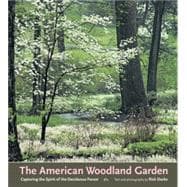
Note: Supplemental materials are not guaranteed with Rental or Used book purchases.
Purchase Benefits
What is included with this book?
| Preface | |
| Acknowledgments | |
| A Forest Aesthetic | |
| Forest Dynamics | |
| Luminous Qualities | |
| Color Cycles | |
| Foliage Color Cycles | |
| Flower Color Cycles | |
| Constant Colors | |
| An Evergreen Presence | |
| Time and Transition | |
| Forest Architecture | |
| Layers | |
| Canopy | |
| Mid-level or Understory Trees | |
| Shrub Layer | |
| Herbaceous Layer | |
| Ground Layer | |
| Vines | |
| Areas | |
| Interior | |
| Edge | |
| Roadside Woodlands and Forest Relics | |
| Diversity and the Beauty of Provenance | |
| Exotic Questions | |
| Learning from a Woodland Stream | |
| Designing the Woodland Garden | |
| Abstracting the Forest | |
| Framing and Enclosing | |
| Working with Layers | |
| Celebrating and Encouraging Natural Form | |
| Gardening at the Edge | |
| Integrating Exotics | |
| Working with Textures and within the Color Green | |
| The Influence of Evergreens | |
| Celebrating Natural Light in the Woodland Garden | |
| Woodland Walks and Pathways | |
| The Woodland Garden Dwelling | |
| Planting and Maintaining the Woodland Garden | |
| Selecting and Acquiring Plants | |
| The Ethics of Acquisition | |
| Starting Plants from Seed | |
| Purchasing Plants | |
| Respecting Roots | |
| Matching Plants to Available Light | |
| Hardiness | |
| Woodland Soils | |
| Acidity and Alkalinity | |
| Organic Matter and Fertility | |
| Moisture and Drainage | |
| Covering the Ground | |
| New Planting and Transplanting | |
| Pruning and Cutting Back | |
| Pests and Diseases | |
| Weeds | |
| The Forest Palette | |
| Acer | |
| Aconitum | |
| Actaea | |
| Aesculus | |
| Agastache | |
| Allium | |
| Alnus | |
| Amelanchier | |
| Anemone | |
| Anemonella | |
| Aquilegia | |
| Aralia | |
| Arisaema | |
| Aristolochia | |
| Aronia | |
| Aruncus | |
| Asarum | |
| Asclepias | |
| Asimina | |
| Aster | |
| Astilbe | |
| Betula | |
| Caltha | |
| Calycanthus | |
| Campanula | |
| Carpinus | |
| Carya | |
| Caulophyllum | |
| Ceanothus | |
| Cercis | |
| Chionanthus | |
| Chrysogonum | |
| Cimicifuga | |
| Claytonia | |
| Clethra | |
| Clintonia | |
| Cornus | |
| Cotinus | |
| Crataegus | |
| Cyrilla | |
| Delphinium | |
| Dentaria | |
| Dicentra | |
| Dioscorea | |
| Diospyros | |
| Diphylleia | |
| Dirca | |
| Echinacea | |
| Erythronium | |
| Euonymus | |
| Eupatorium | |
| Fagus | |
| Ferns | |
| Fothergilla | |
| Fraxinus | |
| Galax | |
| Gentiana | |
| Geranium | |
| Gillenia | |
| Grasses, Sedges, and Wood-rushes | |
| Gymnocladus | |
| Halesia | |
| Hamamelis | |
| Heuchera | |
| Hexastylis | |
| Houstonia | |
| Hydrangea | |
| Hydrastis | |
| Ilex | |
| Iris | |
| Isopyrum | |
| Itea | |
| Jeffersonia | |
| Juniperus | |
| Kalmia | |
| Leucothoe | |
| Lilium | |
| Lindera | |
| Liquidambar | |
| Liriodendron | |
| Lonicera | |
| Magnolia | |
| Maianthemum | |
| Mertensia | |
| Mitchella | |
| Mitella | |
| Monarda | |
| Neviusia | |
| Nyssa | |
| Ostrya | |
| Oxydendrum | |
| Pachysandra | |
| Panax | |
| Parthenocissus | |
| Phacelia | |
| Phlox | |
| Pieris | |
| Platanus | |
| Podophyllum | |
| Polemonium | |
| Polygonatum | |
| Quercus | |
| Rhododendron | |
| Rhus | |
| Rubus | |
| Sambucus | |
| Sanguinaria | |
| Sassafras | |
| Sedum | |
| Senecio | |
| Silene | |
| Smilacina | |
| Solidago | |
| Spigelia | |
| Staphylea | |
| Stewartia | |
| Stylophorum | |
| Styrax | |
| Symplocarpus | |
| Tiarella | |
| Trillium | |
| Tsuga | |
| Uvularia | |
| Vaccinium | |
| Veratrum | |
| Veronicastrum | |
| Viburnum | |
| Viola | |
| Wisteria | |
| Xanthorhiza | |
| Plant Sources USDA Hardiness Zone Map | |
| Glossary | |
| Bibliography | |
| Index | |
| Table of Contents provided by Publisher. All Rights Reserved. |
The New copy of this book will include any supplemental materials advertised. Please check the title of the book to determine if it should include any access cards, study guides, lab manuals, CDs, etc.
The Used, Rental and eBook copies of this book are not guaranteed to include any supplemental materials. Typically, only the book itself is included. This is true even if the title states it includes any access cards, study guides, lab manuals, CDs, etc.